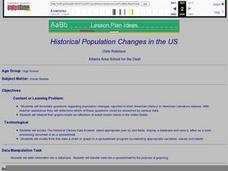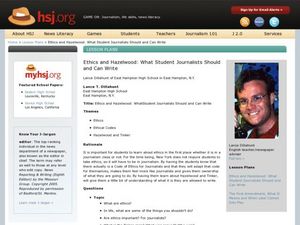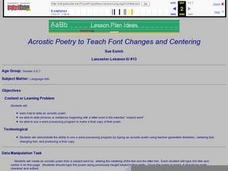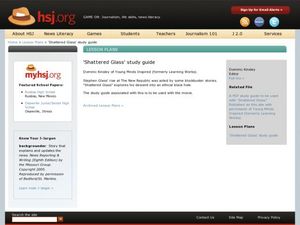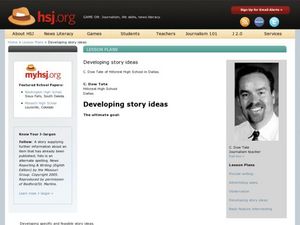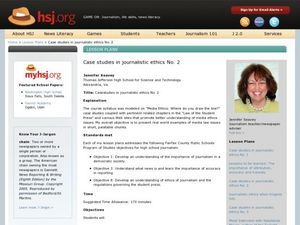Curated OER
Historical Population Changes in the US
Students conduct research on historical population changes in the U.S. They conduct Internet research on the Historical Census Data Browser, create a bar graph and data table using a spreadsheet program, and display and interpret their...
ProCon
Drinking Age
Eighteen is the age of adulthood in the United States, but 21 is the legal drinking age. Pupils use the provided website to determine whether the age to legally purchase and consume alcohol should be lowered. They weigh the pros and...
Curated OER
Ethics and Hazelwood: What Journalists Should and Can Write
Students explore the code of ethics in journalism. In this journalism ethics lesson, students use Hazelwood and Tinker to explore journalism ethics. Students compare ethics of journalists and pirates, read a related article, write their...
Curated OER
Using Spreadsheets and Graphs
Third graders explore mathematics by utilizing computers. In this graphing lesson, 3rd graders gather class data based on a particular topic such as the "favorite candy" of the class. Students utilize this information and computers to...
Curated OER
Daily Lesson Plan # 9
Students review materials covered in previous class. They continue the tutorial in the textbook "Creative HTML Design", chapter 4, pages 78-83. Students work with browser safe colors. They open the CD that came with their textbook,...
Curated OER
Sweet Data
Young scholars input data about the colors of their serving of M&M candies onto a spreadsheet. They create charts and graphs based on this information.
Curated OER
Who Do You Know?
Pupils research and describe the contributions of African-American men and women. They write their notes in a Microsoft Word document. They present their information to the class.
Curated OER
Acrostic Poetry to Teach Font Changes and Centering
Young scholars engage in a discussion about how to write an acrostic poem. They demonstate the ability to use a word processor by typing an acrostic poem by following instructions. Word processing skills such as, centering text, changing...
Curated OER
Use of Lasers
Students explore the use of lasers. In this "lasers" science and career education instructional activity, students search the Internet to find uses for lasers and make a list of companies that use or produce lasers. Students complete a...
Curated OER
Tinker Toys
Students explore various computer items. They describe possible alternative uses for computer technology. Students explore the practice of "reverse engineering." They write an opinion essay on the ethics behind "reverse engineering."
Curated OER
Shattered Glass Study Guide
Students view a movie about ethical journalism and Stephen Glass' rise at The New Republic. In this news ethics instructional activity, students view "Shattered Glass" and explore Glass' descent into an ethical black hole....
Curated OER
Computation with Fractions
Upper graders are introduced to the topic of fractions and percentages. In groups, they discuss real world situations in which fractions are present, and they complete a worksheet solving problems with common and uncommon denominators....
Curated OER
Developing Story Ideas
Students complete activities to learn how to develop story ideas in journalistic writing. In this story ideas lesson, students learn news value judging criteria, identify language to ask beat sources for story ideas, distinguish story...
Curated OER
What is a Dictionary?
Second graders explore the purpose of a dictionary. In this library media instructional activity, 2nd graders explore My First Dictionary and identify guidewords, entry words, and captions. Students list ways they can use the dictionary.
Curated OER
Case Studies in Journalistic Ethics No. 2
Learners use texts on media ethics and various Web sites to explore real world examples of media law issues. For this media ethics lesson, young scholars examine the Food Lion case using a transcript from...
